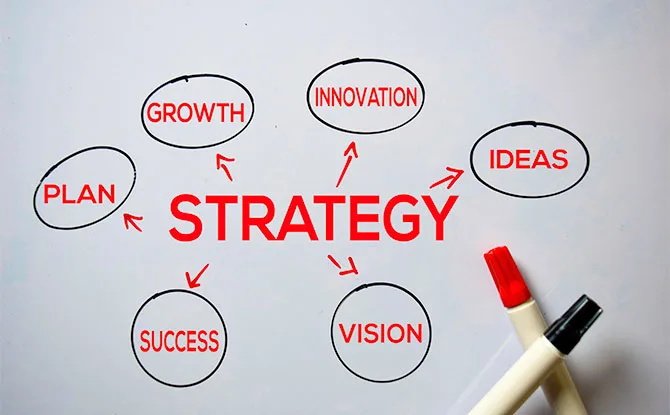In today’s competitive business landscape, successful marketing requires a well-rounded approach that combines both tactics and strategy. While the terms marketing tactics and strategy are often used interchangeably, they represent distinct aspects of marketing that are essential for achieving business success.
Marketing tactics refer to the specific actions taken to execute a marketing strategy. These actions can include social media marketing, email campaigns, content marketing, and more. On the other hand, marketing strategy is the overarching plan that outlines long-term goals and overall direction. A well-defined marketing strategy helps businesses to achieve their marketing goals, reach their target audience, and stay ahead of the competition.
In this article, we dive deep into the differences between marketing tactics and strategy and explore how they work together to drive business success. We’ll provide insights on how to craft an effective marketing strategy, choose the right tactics, and integrate them seamlessly for optimal results. We will also discuss the importance of measuring and adjusting your marketing approach to stay agile in a dynamic marketing landscape.
Key Takeaways: Marketing Tactics vs Strategy

- Marketing tactics and strategy are two distinct but complementary aspects of marketing.
- A well-defined marketing strategy is essential for achieving long-term goals and overall direction.
- Marketing tactics refer to the specific actions taken to execute a marketing strategy.
- Choosing the right tactics to complement your chosen strategy is crucial for optimal results.
- Integrating marketing tactics and strategy is necessary for avoiding disjointed marketing efforts.
- Measuring and adjusting your marketing approach is essential for optimizing your marketing efforts.
- Staying agile in a rapidly changing marketing landscape is vital for achieving marketing success.
Understanding Marketing Strategy

Marketing strategy is the roadmap that guides your marketing efforts toward achieving specific business goals. To effectively plan and execute a marketing strategy, it’s essential to have a well-defined marketing plan. A marketing plan outlines the specific actions you’ll take to achieve your marketing goals.
Before you can create a marketing plan, you need to define your marketing goals. These goals should be specific, measurable, attainable, relevant, and time-bound (SMART). Your goals might include increasing website traffic, generating leads, boosting sales, or building brand awareness.
Once you have your goals defined, it’s time to conduct a thorough analysis of your market and competitors. You should identify your target audience, understand their needs and pain points, and evaluate how your competitors are meeting those needs. This analysis will inform your marketing strategy and help you differentiate yourself in a crowded marketplace.
A critical element of any marketing strategy is your value proposition. Your value proposition is the unique benefit you offer to your target audience that sets you apart from your competitors. It should be clear, concise, and compelling.
Positioning is another key consideration when developing a marketing strategy. Positioning refers to how you want your target audience to perceive your brand relative to your competitors. It’s essential to identify your unique selling proposition (USP) and develop messaging that effectively communicates your USP to your target audience.
Strategic marketing involves aligning your marketing efforts with your overall business goals. This requires a deep understanding of your target audience, market, and competitors to develop a marketing strategy that works. A well-crafted marketing strategy will guide your tactical marketing decisions, helping you select the right tactics to achieve your marketing goals.
- Marketing strategy is the roadmap that guides your marketing efforts toward specific business goals.
- A well-defined marketing plan is essential to creating an effective marketing strategy.
- Marketing goals should be specific, measurable, attainable, relevant, and time-bound (SMART).
- Market and competitor analysis, value proposition, and positioning are all critical elements of a solid marketing strategy.
- Strategic marketing requires aligning your marketing efforts with your overall business goals.
The Power of Marketing Tactics

While marketing strategy provides overall direction for a business, marketing tactics are the specific actions taken to execute that strategy. Tactics are essential to achieving marketing goals and must be carefully selected based on factors such as target audience, industry, and business goals.
Some examples of marketing tactics include social media advertising, email marketing campaigns, search engine optimization (SEO), content marketing, and influencer marketing. These tactics can be used individually or in combination to execute a marketing strategy.
When selecting which marketing tactics to use, it’s important to have a clear understanding of the target audience and their preferences. For instance, if the target audience consists mainly of young adults, social media advertising may be an effective tactic to reach them. On the other hand, if the target audience is older, email marketing may be a better option.
It’s also important to consider the industry when selecting which tactics to use. For example, a B2B company may find that attending industry events and networking with potential clients is a more effective tactic than social media advertising.
Ultimately, the key to effective tactical marketing is to select the right tactics that complement the overall strategy, and to measure the effectiveness of those tactics to ensure they are driving results toward the marketing goals.
Differentiating Between Tactics and Strategy
While the terms “marketing tactics” and “marketing strategy” are often used interchangeably, they are actually two distinct concepts. A marketing strategy refers to a long-term plan that outlines the direction, goals, and objectives of your marketing efforts. On the other hand, marketing tactics are the specific actions you take to execute that strategy, such as running a social media campaign or launching a new product line.
It is important to understand the differences between these two concepts because they require different levels of investment and deliver different outcomes. A well-defined strategy provides a clear roadmap for achieving your marketing goals over time, while tactics are the vehicles that help you move along that roadmap.
Think of it like a road trip. Your strategy is the map that outlines the route you will take to reach your destination, while tactics are the various methods of transportation that you use to get there, such as a car, train, or plane.
How Tactical Decisions Support Strategic Goals
When selecting tactics to support your marketing strategy, it is important to keep your goals and objectives in mind. Your tactics should align with your overall marketing plan and support your strategic goals. For example, if your strategy is to increase brand awareness, your tactics might include running a social media campaign, creating targeted content, or launching a PR campaign.
It is also important to consider your target audience, industry trends, and competitors when selecting tactics. For example, if you are targeting a younger demographic, you might focus on social media and influencer marketing, while if your industry is highly regulated, you may need to focus on compliance and regulation requirements in your tactics.
By understanding the differences between marketing tactics and strategy, and how they work together, you can create a well-aligned approach that maximizes your marketing investment and drives business success.
Crafting an Effective Marketing Strategy
A well-defined marketing strategy is critical to achieving business goals. It provides a clear roadmap for all marketing activities, ensuring they align with overall objectives. Here are some key steps to crafting an effective marketing strategy:
- Identify your target audience: Clearly define your ideal customer and understand their needs, preferences, and behaviors. This information will help shape your messaging and tactics.
- Conduct a competitive analysis: Evaluate your competitors’ strengths, weaknesses, and market positioning. This information will help you determine how to differentiate your brand and stand out in the market.
- Define your value proposition: Determine what sets your product or service apart from the competition and how it solves your target audience’s pain points.
- Position your brand: Develop a unique brand identity that resonates with your target audience and aligns with your value proposition.
- Set SMART goals: Define specific, measurable, achievable, relevant, and time-bound marketing goals. This will enable you to track progress and adjust strategies as needed.
- Select appropriate tactics: Based on your target audience, competitive analysis, and value proposition, choose the marketing tactics that are best suited to achieving your goals.
- Create a marketing plan: Develop a detailed plan that outlines how you will execute your chosen tactics and achieve your marketing goals. Ensure this plan aligns with your overall business plan.
- Allocate resources: Determine the budget and resources required to execute your marketing plan effectively.
By following these steps, you can create a comprehensive and effective marketing strategy that drives business success.
Choosing the Right Tactics for Your Strategy
Now that you have a clear understanding of marketing tactics and strategy, it’s essential to select the appropriate tactics that align with your chosen marketing strategy. Your marketing tactics should complement your overall marketing goals and provide a clear path to achieving them.
When choosing your marketing tactics, it’s essential to take a strategic approach. Consider your target audience, industry, and competitive landscape. Your tactics should be tailored to your unique business needs and goals.
One way to ensure your tactics are aligned with your strategy is to use strategic marketing decisions to inform your tactical choices. Focus on the tactics that will help you achieve your long-term goals while still being flexible enough to adjust your approach as needed.
Remember, the right marketing tactics can help you reach your target audience effectively and efficiently, leading to increased engagement and conversions. By making informed decisions, you can optimize your marketing approach and boost your business success.
Integrating Strategy and Tactics
Now that you understand the differences between marketing tactics and strategy, it’s important to note that they work best when integrated. Combining tactics with a well-defined strategy can help you achieve your business objectives efficiently and effectively.
One way to ensure that your tactics align with your overall marketing strategy is to use strategic marketing decisions to guide your tactical choices. By doing so, you’ll be able to select tactics that not only resonate with your target audience but also complement your long-term marketing goals.
Integrating tactics and strategy also avoids disjointed marketing efforts. Without integration, your tactics may lack direction and your strategy may not be executed effectively. This can lead to wasted resources and conflicting messaging, ultimately harming your business objectives.
By combining your marketing tactics and strategy, you can create synergy between the two, resulting in greater success for your business. So, make sure to take the time to align your tactics with your strategy and enjoy the benefits of this well-balanced approach.
Measuring and Adjusting Your Marketing Approach
Measuring and adjusting your marketing approach is crucial to achieving your marketing goals. It allows you to evaluate the effectiveness of your marketing strategies and tactics and optimize your efforts based on data-driven insights.
Having a well-defined marketing plan with clear objectives and KPIs is the first step to measuring your marketing efforts. Ensure that you have a system in place to track relevant metrics, such as website traffic, leads generated, conversions, and customer engagement.
Use analytics tools, such as Google Analytics or HubSpot, to gather data and analyze trends. This allows you to identify what works and what doesn’t, and adjust your marketing approach accordingly.
Regularly review your marketing plan and KPIs to ensure that they are still aligned with your business goals. Consider adjusting your strategies and tactics if you notice a decline in performance or changes in market trends.
It’s also essential to communicate with your team and stakeholders to ensure that everyone is on the same page and working towards the same objectives. Share regular updates and reports on the progress of your marketing efforts and discuss any adjustments or changes that need to be made.
By consistently measuring and adjusting your marketing approach, you can optimize your efforts and achieve your marketing goals more effectively.
The Power of Staying Agile in a Dynamic Marketing Landscape
Marketing is an ever-changing landscape, and it is crucial for marketers to stay agile and adapt to changing trends and consumer behavior. Agility allows marketers to pivot quickly and remain relevant, resulting in effective marketing strategies. Here are some tips for staying agile:
- Keep up with emerging trends: Stay informed about emerging technologies, social media platforms, and marketing trends. Keep an eye on data and metrics to determine which channels are performing the best and adjust accordingly.
- Be flexible: Adapting to changes quickly is essential in a fast-paced environment. Be ready to shift tactics or strategies as needed to optimize results.
- Continuously learn: The marketing landscape is constantly evolving, and ongoing education is necessary to stay current. Attend industry conferences, participate in webinars or podcasts, and read industry publications to stay up-to-date.
By staying agile, marketers can ensure their strategies remain effective, and they achieve their marketing goals. Always be willing to pivot when necessary and make data-driven decisions to optimize your marketing approach.
Conclusion
Marketing tactics and strategy are both crucial components in achieving business success. While marketing strategy focuses on the long-term direction and overall goals, marketing tactics are the specific actions taken to execute a strategy. It is essential to strike a balance between the two for optimal results.
Creating an effective marketing strategy requires careful consideration of factors such as target audience, competitive analysis, value proposition, and positioning. Choosing the right marketing tactics to align with the chosen strategy is equally important. It is essential to make data-driven decisions by tracking KPIs and using analytics to evaluate the effectiveness of both tactics and strategy.
Staying agile in a dynamic marketing landscape is key to maintaining marketing success. Adapting strategies and tactics to suit evolving consumer behaviors, emerging technologies, and market trends is crucial. Continuous learning and flexibility is necessary to stay ahead of the competition.
By implementing a well-balanced marketing approach and making informed decisions, businesses can achieve their marketing goals and boost overall success.
FAQ
Q: What is the difference between marketing tactics and strategy?
A: Marketing tactics refer to the specific actions taken to execute a marketing strategy. On the other hand, marketing strategy focuses on long-term goals and overall direction. While tactics are the how, strategy is the why behind those actions.
Q: Why are both marketing tactics and strategy important?
A: Both marketing tactics and strategy are essential for effective marketing. Tactics help execute the strategy and achieve short-term goals, while strategy provides a roadmap for long-term success. Balancing both aspects ensures a cohesive and well-aligned approach.
Q: What elements should be considered when crafting a marketing strategy?
A: When creating a marketing strategy, it’s crucial to consider your target audience, competitive analysis, value proposition, and positioning. These elements help define your direction and goals, allowing you to create an effective strategy.
Q: How do you choose the right tactics for your marketing strategy?
A: Selecting the right tactics involves aligning them with your overall marketing goals and strategic decisions. By understanding your target audience, industry, and business objectives, you can make informed choices that complement your chosen strategy.
Q: Why is it important to integrate marketing tactics and strategy?
A: Integrating marketing tactics and strategy creates a cohesive approach that maximizes results. By aligning your tactics with your strategic goals, you ensure that all marketing efforts work together towards a common objective, avoiding disjointed or conflicting messages.
Q: How can you measure and adjust your marketing approach?
A: Measuring and adjusting your marketing efforts is crucial for optimizing results. Tracking key performance indicators (KPIs) and using analytics allows you to assess the effectiveness of both your tactics and strategy. By making data-driven decisions, you can continuously refine your approach.
Q: How can marketers stay agile in a dynamic marketing landscape?
A: Staying agile in a rapidly changing marketing landscape requires adaptability and continuous learning. Marketers should be open to evolving consumer behaviors, emerging technologies, and market trends. By staying informed and flexible, marketers can adjust their strategies and tactics to stay ahead.

